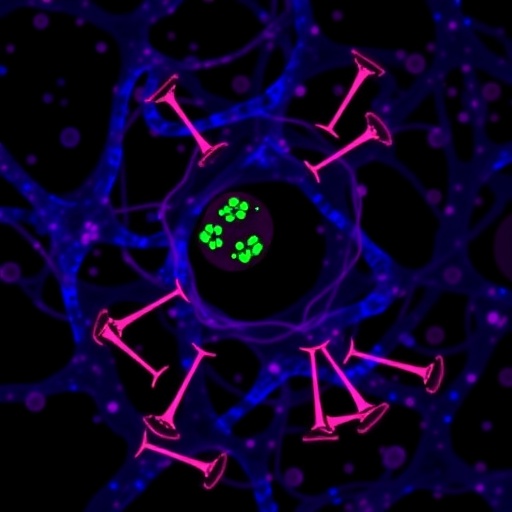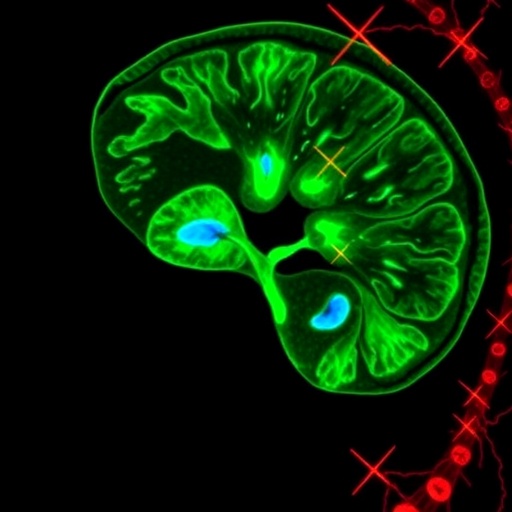In the ever-evolving field of oncology, understanding the intricate relationship between the immune system and cancer progression has become pivotal. A groundbreaking study recently published in BMC Cancer has shone light on diffuse large B-cell lymphoma (DLBCL), one of the most aggressive forms of non-Hodgkin lymphoma, unveiling a new prognostic biomarker with far-reaching implications. Researchers have identified that the ratio of interferon-gamma (IFN-γ) to interleukin-4 (IL-4) within patients serves as an influential indicator of disease prognosis, potentially revolutionizing how clinicians predict patient outcomes and tailor treatments.
DLBCL presents a complex clinical challenge due to its inherent biological heterogeneity and the pivotal role that immune dysregulation plays in its pathogenesis. While existing prognostic tools such as the International Prognostic Index (IPI) provide valuable risk stratification, they often fall short in capturing the nuanced immunological milieu influencing disease trajectory. This new study focuses on evaluating immune-related markers—specifically lymphocyte subsets and cytokine profiles—that directly reflect the host immune response against lymphoma cells.
The underlying premise revolves around the balance between two critical types of T helper cells, Th1 and Th2, which orchestrate divergent immune reactions. Th1 cells, typically marked by their production of IFN-γ, promote a pro-inflammatory, cell-mediated immune response that can suppress tumor growth. Conversely, Th2 cells secrete IL-4, often associated with anti-inflammatory effects that might facilitate tumor evasion. Hence, the ratio of IFN-γ to IL-4 offers a window into the immune system’s dominance and its capacity to combat or inadvertently assist lymphoma progression.
Leveraging data from 94 newly diagnosed DLBCL patients treated between 2017 and 2023, the researchers conducted a meticulous retrospective analysis. They scrutinized patients’ clinical and laboratory parameters, including peripheral blood T lymphocyte subsets (particularly CD4+ and CD8+ T cells) and cytokine concentrations. Survival outcomes such as progression-free survival (PFS) and overall survival (OS) were evaluated through rigorous statistical models, including Kaplan–Meier survival analysis and Cox proportional hazards regression.
Findings revealed that a high IFN-γ/IL-4 ratio correlated strongly with improved clinical outcomes. Patients exhibiting elevated ratios demonstrated significantly prolonged PFS and OS, indicating a more robust anti-tumor immune response. This link was further accentuated by the observation that elevated CD4+ T cell counts—often representing helper cells facilitating immune activation—were also favorable for prognosis. These results underscore the importance of immune competence in constraining lymphoma progression and suggest that the IFN-γ/IL-4 ratio could serve as a dynamic marker reflecting the effective immune landscape in individual patients.
Intriguingly, multivariate analysis pointed to age as a marginally significant factor associated with poorer overall survival, aligning with prior knowledge that advancing age generally portends worse outcomes in lymphoma patients. Simultaneously, low CD8+ T cell counts were linked to inferior progression-free survival, highlighting the crucial role of cytotoxic T lymphocytes in suppressing tumor growth and eliminating malignant cells.
Beyond these baseline observations, the study offers critical insights into treatment response dynamics. Elevated pretreatment IFN-γ/IL-4 ratios were predictive of favorable responses to therapy, while lower ratios were evident in patients who experienced disease progression during subsequent treatment cycles. This suggests that the IFN-γ/IL-4 ratio not only reflects current immune status but may also serve as a biomarker for monitoring therapeutic efficacy and emerging resistance.
Capitalizing on these findings, the team developed an immune-related prognostic score (IRPS) model integrating three parameters: age, CD4+ T cell count, and the IFN-γ/IL-4 ratio. This composite scoring system effectively stratified patients into high-risk and low-risk categories with distinct survival outcomes. High-risk patients exhibited markedly worse overall survival compared to their low-risk counterparts, indicating that the IRPS could refine and complement established prognostic indices like the IPI.
Importantly, the IRPS model’s robustness was validated in an independent patient cohort, confirming its reproducibility and potential clinical applicability. This validation underscores the translational promise of the IRPS, presenting an accessible, immune-centric tool that could be readily incorporated into clinical workflows to guide decision-making.
The implications of these revelations are profound. The IFN-γ/IL-4 ratio taps directly into the immunological tug-of-war at the heart of lymphoma biology. By quantifying the delicate balance between pro-inflammatory and anti-inflammatory cytokine milieus, clinicians can obtain a more nuanced understanding of disease behavior beyond traditional histopathological or molecular markers. Such immunological profiling can inform risk stratification, personalize therapy, and possibly unveil novel therapeutic targets aimed at modulating the immune landscape.
Furthermore, this research exemplifies the growing trend towards integrating immune biomarkers into oncology practice, reflecting the burgeoning field of immuno-oncology. As cancer treatment increasingly harnesses immunotherapeutic strategies—such as immune checkpoint inhibitors and CAR T-cell therapies—identifying reliable biomarkers becomes paramount to optimize patient selection and monitor responses.
Nevertheless, some questions remain open. The study’s retrospective nature, while informative, necessitates prospective clinical trials to further validate and potentially refine the prognostic utility of the IFN-γ/IL-4 ratio and IRPS model. Additionally, investigating the biological mechanisms underpinning the cytokine ratio’s impact on lymphoma progression may uncover therapeutic vulnerabilities that can be exploited.
Moreover, the role of other immune subsets, including regulatory T cells, natural killer cells, and myeloid-derived suppressor cells, warrants exploration, as these populations also intricately influence the tumor microenvironment. Monitoring how these cells interact with Th1/Th2 balances could augment prognostic models and deepen our understanding of lymphoma immunobiology.
In summary, this landmark study introduces the IFN-γ/IL-4 ratio as a practical and potent prognostic biomarker in DLBCL, expanding the immune toolkit available to oncologists. The development and validation of the IRPS model mark a significant stride toward incorporating immune parameters into lymphoma prognostication and potentially into therapeutic paradigms. As the quest for personalized cancer care advances, such immune-based indicators will undoubtedly play an increasingly influential role.
By translating immunological insights into clinical practice, researchers hope to improve survival outcomes and quality of life for patients battling this formidable malignancy. The IFN-γ/IL-4 ratio and the IRPS model represent beacons of precision medicine, exemplifying how deepening the integration of immunology and oncology can unlock new frontiers in cancer management.
Subject of Research: Prognostic biomarkers and immune-related prognostic modeling in diffuse large B-cell lymphoma (DLBCL).
Article Title: Identification of the IFN-γ/IL-4 ratio as a prognostic biomarker and development of an immune-related prognostic model in diffuse large B-cell lymphoma.
Article References:
Zhou, P., Zhou, Y., Yang, L. et al. Identification of the IFN-γ/IL-4 ratio as a prognostic biomarker and development of an immune-related prognostic model in diffuse large B-cell lymphoma. BMC Cancer 25, 1386 (2025). https://doi.org/10.1186/s12885-025-14737-1
Image Credits: Scienmag.com
DOI: https://doi.org/10.1186/s12885-025-14737-1
Tags: biological heterogeneity in cancercancer immune response indicatorscytokine profiles in oncologydiffuse large B-cell lymphoma prognosisIFN-γ IL-4 ratioimmune dysregulation in DLBCLimmune system cancer relationshiplymphocyte subsets in lymphomanon-Hodgkin lymphoma outcomesoncology treatment personalizationprognostic biomarkers lymphomaT helper cell balance Th1 Th2





